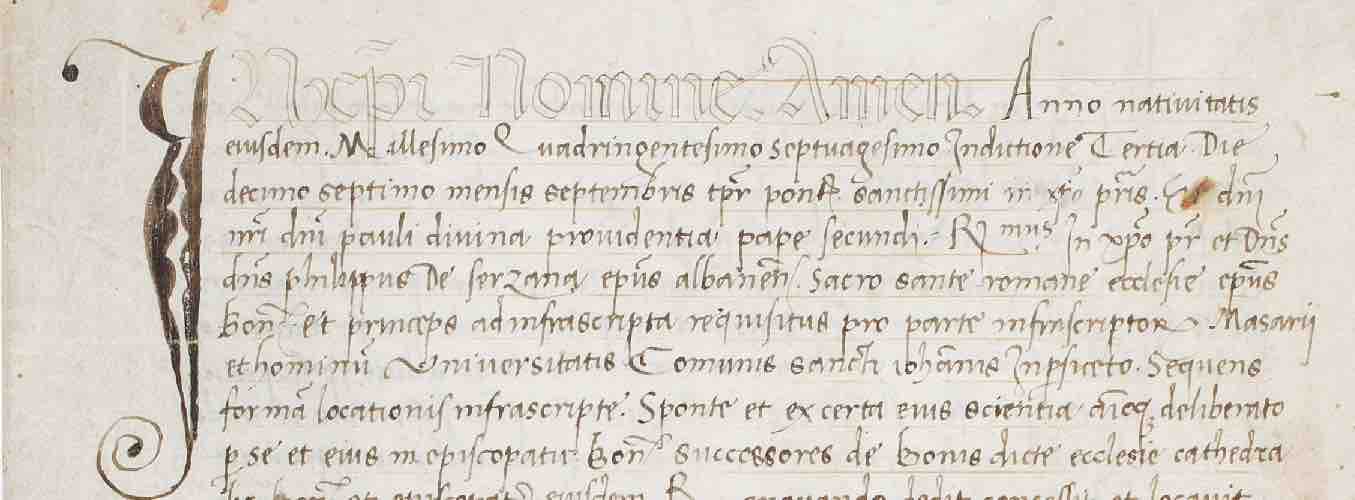Transcribe
Latin Humanist - Transcription

Description
The reformed scripts of Italian humanists of the 15th century, Humanist Minuscule and Humanist Cursive. Features of Humanist page layout compared to Carolingian and Gothic page design.
Introduction
Transcribe the entire page from Cod. Bodmer 137 starting on line 3. (The top two lines in red are too faded to read easily. You do not need to transcribe the inscription at the bottom.)
Script and abbreviations
Transcribing Humanist Minuscule should be a relief after the other scripts you have tangled with during this course! However, this is the manuscript we looked at in the Humanist Paleography lesson that was written by a Northern Italian scribe steeped in Gothic habits, so you will notice some fusions, and there are quite a few abbreviations.
Below are the abbreviations that may cause confusion. When expanding these, remember to use parentheses to indicate which letters you are supplying, as in previous lessons.
Abbreviations utilized in Cod. Bodmer 137
| q3 | In earlier lessons, you saw que abbreviated by a q followed by a mark of abbreviation that looks like a colon or semicolon: q: or q;. In this manuscript, that is represented by q followed by what looks like a 3. This is actually a variation on q; in which the semicolon-like mark is written with two curved strokes. |
| .N. | stands for enim |
| tn | tn with a mark of abbreviation over it stands for tamen |
| q with strokes through the descender | The q with a straight horizontal line through its descender stands for qui. A q with a stroke through its descender that curves diagonally up to the right stands for qua. If you put those abbreviations together with what you know about how the common mark of abbreviation works, you should be able to work out any more complex abbreviations on this page that you have not seen before. |
| oio | stands for omnino |
| & with a titulus | The ampersand with the common mark of abbreviation over it stands for etiam. |
You should be able to figure out the other simple suspensions and contractions from your previous experience with abbreviations and your knowledge of Latin.
The generous word spacing in this manuscript might trick you into thinking the scribe’s word separation is entirely correct, but it is not. Stay alert! And when hyphenating word breaks at line end, notice where the scribe has used a very long, almost-invisible hyphen, and where he has omitted the hyphen. Remember to put the hyphen in parentheses if you supply it yourself.
Exercise 1
3
4
5
6
7
8
9
10
11
12
13
14
15
16
17
18
19
20
21
Cologny, Fondation Martin Bodmer, Cod. Bodmer 137, f. 1r. (www.e‑codices.unifr.ch)
Transcription Answer
4. hementer amabam Platonem tu-
5. um sic (e)n(im) mihi placet appellare il(-)
6. lum pro quo tu aduersus indo-
7. ctorum turbam omni tempore pugnauisti t(ame)n
8. ex quo hunc dialogum in latinum facere inc/o\e(-)
9. pi tantus mihi beniuolentiȩ cumulus accrescit.´
10. ut nunc demum amare ip(su)m uidear prius au-
11. tem solu(m)modo dilexisse. Caue (e)n(im) existimes q(ui)c-
12. q(uam) o(mn)i(n)o reperiri posse quod aut sapientius scrip-
13. tum sit.´ aut facundius.´ Quod quidem ego n(un)c
14. magis q(uam) antea intelligo. Cum ob conuertendi
15. diligentiam singula eius uiri dicta conteram
16. atq(ue) olfaciam necesse est. Maximas igitur co-
17. lucio patri et preceptori meo gratias ago. qui
18. iniungendo hoc munere tantum mihi bene-
19. ficium attulit. Prius (e)n(im) duntaxat Platonem
20. uideram nunc et(iam) ut mihi uideor cognoui.
21. Cuius ego libros si aliquando absoluero et lati-